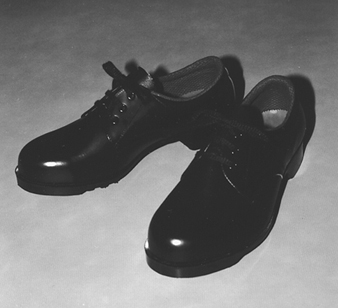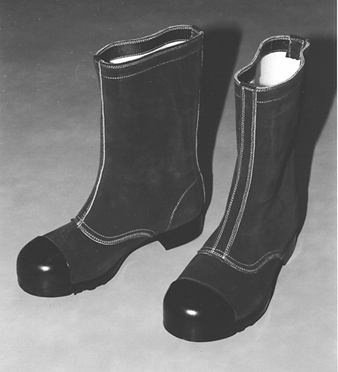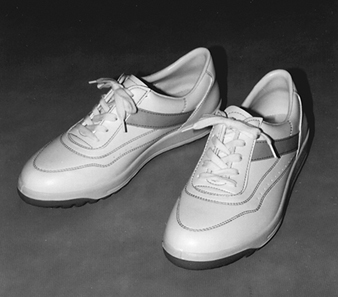Injuries to the foot and leg are common to many industries. The dropping of a heavy object may injure the foot, particularly the toes, in any workplace, especially among workers in the heavier industries such as mining, metal manufacture, engineering and building and construction work. Burns of the lower limbs from the molten metals, sparks or corrosive chemicals occur frequently in foundries, iron- and steelworks, chemical plants and so on. Dermatitis or eczema may be caused by a variety of acidic, alkaline and many other agents. The foot may also suffer physical injury caused by striking it against an object or by stepping on sharp protrusions such as can occur in the construction industry.
Improvements in the work environment have made the simple puncturing and laceration of the worker’s foot by protruding floor nails and other sharp hazards less common, but accidents from working on damp or wet floors still occur, particularly when wearing unsuitable foot wear.
Types of Protection.
The type of foot and leg protection should be related to the risk. In some light industries, it may be sufficient hat workers wear well-made ordinary shoes. Many women, for example will wear footwear that is comfortable to them, such as sandals or old slippers, or footwear with very high or worn-down heels. This practice should be discouraged because such footwear can cause an accident.
Sometimes a protective shoe or clog is adequate, and sometimes a boot or leggings will be required (see figure 1, figure 2 and figure 3). The height to which the footwear covers the ankle, knee or thigh depends on the hazard, although comfort and mobility will also have to be considered. Thus shoes and gaiters may in some circumstances be preferable to high boots.
Figure 1. Safety shoes
Figure 2. Heat protective boots
Protective shoes and boots may be made from leather, rubber, synthetic rubber or plastic and may be fabricated by sewing, vulcanizing or moulding. Since the toes are most vulnerable to impact injuries, a steel toe cap is the essential feature of protective footwear wherever such hazards exist. For comfort the toe cap must be reasonably thin and light, and carbon tool steel is therefore used for this purpose. These safety toe caps may be incorporated into many types of boots and shoes. In some trades where falling objects present a particular risk, metal instep guards may be fitted over protective shoes.
Rubber or synthetic outer soles with various tread patterns are used to minimize or prevent the risk of slipping: this is especially important where floors are likely to be wet or slippery. The material of the sole appears to be of more importance than the tread pattern and should have a high coefficient of friction. Reinforced, puncture-proof soles are necessary in such places as construction sites; metallic insoles can also be inserted into various types of footwear that lack this protection.
Where an electrical hazard exists, shoes should be either entirely stitched or cemented, or directly vulcanized in order to avoid the need for nails or any other electrically conductive fasteners. Where static electricity may be present, protective shoes should have electrically conductive rubber outer soles to allow static electricity to leak from the bottom of the shoes.
Footwear with a dual purpose has now come into common use: these are shoes or boots that have both anti-electrostatic properties mentioned above together with the ability to protect the wearer from receiving an electrical shock when in contact with a low-voltage electrical source. In the latter case, the electrical resistance between the insole and the outer sole must be controlled in order to provide this protection between a given voltage range.
In the past, “safety and durability” were the only considerations. Now, worker comfort has also been taken into account, so that lightness, comfort and even attractiveness in protective shoes are sought-after qualities. The “safety sneaker” is one example of this kind of footwear. Design and colour may come to play a part in the use of footwear as an emblem of corporate identity, a matter that receives special attention in countries like Japan, to name only one.
Synthetic rubber boots offer useful protection from chemical injuries: the material should show not more than 10% reduction in tensile strength or elongation after immersion in a 20% solution of hydrochloric acid for 48 hours at room temperature.
Especially in environments where molten metals or chemical burns are a major hazard, it is important that shoes or boots should be without tongues and that the fastenings should be pulled over the top of the boot and not tucked inside.
Rubber or metallic spats, gaiters or leggings may be used to protect the leg above the shoe line, especially from risks of burns. Protective knee pads may be necessary, especially where work involves kneeling, for example in some foundry moulding. Aluminized heat-protective shoes, boots or leggings will be necessary near sources of intense heat.
Use and Maintenance
All protective footwear should be kept clean and dry when not in use and should be replaced as soon as necessary. In places where the same rubber boots are used by several people, regular arrangements for disinfection between each use should be made to prevent the spread of foot infections. A danger of foot mycosis exists that arises from the use of too tight and too heavy types of boots or shoes.
The success of any protective footwear depends upon its acceptability, a reality that is now widely recognized in the far greater attention that is now paid to styling. Comfort is a prerequisite and the shoes should be as light as is consistent with their purpose: shoes weighing more than two kilogram per pair should be avoided.
Sometimes foot and leg safety protection is required by law to be provided by the employers. Where the employers are interested in progressive programmes and not just meeting legal obligations, concerned companies often find it very effective to provide some arrangement for easy purchase at the place of work. And if protective wear can be offered at wholesale price, or arrangements for convenient extended payment terms are made available, workers may be more willing and able to purchase and use better equipment. In this way, the type of protection obtained and worn can be better controlled. Many conventions and regulations, however, do consider supplying workers with work clothing and protective equipment to be the employer’s obligation.



